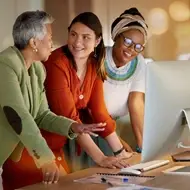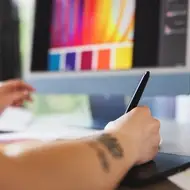5 American Disability Activists You Should Pay Attention To

High-profile activists in the area of disability rights activism, many of whom have disabilities themselves, are changing the way Americans think about disability. We’ve found five such activists of all ages for you to keep an eye on; these are leaders in the space who are making waves and working toward real and lasting change.
Pro tip: Several of the activists below combine disability advocacy with another interest or passion, like film, education, LGBTQ+ rights, voting rights, popular culture, and more. Read on to get inspired by creative ways to work for good.
Anita Cameron – Direct Action
Her career path: Once a Chicago teenager volunteering with justice organizations, Cameron is now a role model in the disability activism community. But her career didn’t start out with the direct action she’s known for today.
Instead, she worked in a position that makes fewer headlines: a Transit Information agent with the Chicago Transit Authority. Through this daily work Cameron observed the challenges many people with disabilities face in transit. Today, thanks to her own activism and the work of others, she uses public transit in most cities without added difficulty.
Cameron continues to help people with disabilities advocate for more accessible transit. She also encourages individuals with disabilities to vote in local and national elections, staff the polls, get prepared for emergencies, and protest cuts to health care resources.
Professionally, Cameron keeps busy on government advisory boards and in grassroots organizations where she trains others to follow her lead. She has worked as an organizer for ADAPT, a nonprofit focused on nonviolent direct action for disability activists, and she’s the Director of Minority Outreach for a grassroots disability rights group.
Where you’ll find her: Cameron is often making headlines for engaging in nonviolent civil disobedience. For example, when Congress considered the Americans with Disabilities Act in 1990, Cameron was at the Capitol building advocating for her rights and the rights of others.
Dominick Evans – Filmmaking
Their career path: An early interest in the performing arts led Evans to study theater in college. They later gravitated toward film and took classes in motion picture production while simultaneously honing their activist tool-kit by engaging in classroom debate.
Evans ultimately decided to use their newfound skills to transform their own colleges’ attitudes toward accessibility. As Wright State University’s Director of Disability Affairs, Evans worked to make campus restrooms more accessible for people with disabilities and for transgender students. Evans is transgender themself and prioritizes fighting for LGBTQ+ rights. You can learn more about their transition journey in the New York Times.
Evans is also hoping to make changes in film and television, since these media don’t always provide accurate portrayals of what it's like to live with a disability. Filmmaking allows Evans to create and explore diverse individual stories. Their film director and writer credits include Trip (2014) and Nance + Sydney (2015).
Where you’ll find them: Evans regularly posts on their blog about their experiences growing up as a person with a disability—follow them to stay updated on their journey and career!
David M. Perry – Journalism
His career path: Perry explores many interests as a journalist, having written about popular television shows, social justice movements, and issues surrounding higher education.
As a historian of the medieval era, Perry is fascinated by history’s relevance to the modern world. Perry may be best known, however, for his thoughts on disability. As a parent of a child with Down Syndrome, he has seen firsthand how education practices can help or harm students with disabilities. Whether schools are working toward inclusion or resisting potentially positive change, Perry adds insight and personal context to the story.
Where you’ll find him: When Perry is not teaching history at the University of Minnesota, he may be providing a nuanced take on current events and how these events affect people with disabilities.
Annie Segarra – Content Creation
Her career path: Segarra, who also goes by Annie Elainey, is a lover of fashion and art. She started out in film, working as an actress with her early interests in activism centering around LGBTQ+ and women’s issues.
An Ehlers-Danlos Syndrome (EDS) diagnosis (along with her experience navigating the complex worlds of fashion design and body image) helped lead Segarra to disability rights activism. They are now dedicated to combating stereotypes in the media through her own growing network—fans of Segarra know her as honest and enthusiastic.
Between media appearances, Segarra keeps busy being creative. She is an artist and musician and has branched out into clothing design as well with “The Future is Accessible” T-shirts.
Where you’ll find her: Segarra is active on YouTube, with a channel that has drawn thousands of followers. They have participated in a multi-genre video conference as a content creator and influencer.
Alice Wong – Media, Storytelling, and Community
Her career path: Wong values community and stories, and has found ways to leverage the digital space in order to bring out the storyteller in everyone.
Wong’s extensive professional background in research led her to a different kind of data collection: a story archive. She is the founder and director of the Disability Visibility Project (DVP), an online community which records and shares disability-related media. Partnering with the oral history organization StoryCorps, the DVP gives people with disabilities a way to share their narratives from their perspectives—a priority for Wong. The DVP compiles oral or spoken histories of people with disabilities and moderates social media groups discussing disability-related issues.
But Wong doesn’t focus exclusively on the stories of others. She is also a published writer, having shared her own stories on a variety of platforms.
Her advocacy led to a national leadership profile and a 2013-2015 appointment to Obama’s National Council on Disability. She wants to set a standard for many others to follow. One of Wong’s goals is to see more people with disabilities "in leadership positions with actual power, not tokens," as she told the Huffington Post. People with disabilities shouldn’t just be included in social impact movements, she argues. They should be actively involved on every level.
Where you’ll find her: Check out Wong's book, Disability Visibility: First-Person Stories from the Twenty-first Century, to see what she's been up to.
Want to Get Involved?
Here’s how you can take part in disability advocacy, even if you don’t turn it into a full-time career.
- Speak up for accessibility rights in your workplace. For example, you can make sure events you’re planning are accessible to attendees with disabilities, whether this means available ramps and elevators at a venue or sign language interpreters for talks. You can also work to ensure that images on your organization's website and social media are accessible.
- Follow disability activists on social media.
- Learn more about virtual volunteer or location-flexible work, which allows many people with disabilities to engage in the social impact sphere.
- Check out idealist.org’s frequently updated list of volunteer opportunities at organizations that work to support individuals with disabilities.
Amy Bergen is a writer based in Portland, Maine. She has experience in the social impact space in Baltimore, Maryland, the educational museum sphere in Columbus, Ohio, and the literary world of New York City.






